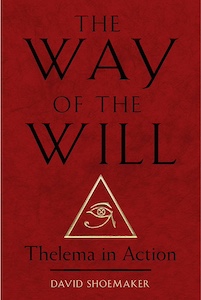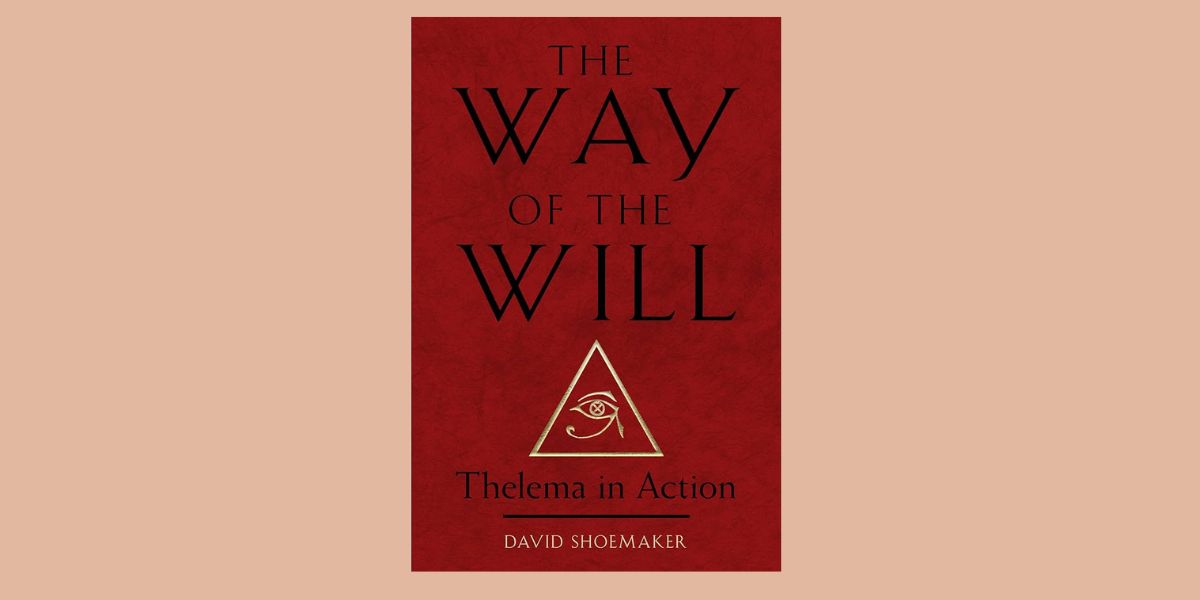
The Way of the Will: Thelema in Action, by David Shoemaker
Weiser Books, 1578638267, 240 pages, May 2024
The vicissitudes of life can strip away everything that grants mortals an illusory sense of identity and stability, but hidden within the core of every human being is a microcosmic star, an immortal spark of divinity, which is the immutable true self. The mystical tradition of Thelema, founded by Aleister Crowley (1875-1947), is a philosophical path for magicians seeking to discover their true selves and align with their life purpose, or True Will, through the alchemical Great Work of personal transformation. (Thelema is a Greek word meaning “will,” specifically the will of a divine being.1) In The Way of the Will: Thelema in Action, author Dr. David Shoemaker provides Thelemic exercises for spiritual growth, utilizing Qabalistic psychology, the Tree of Life, astrology, and excerpts from Crowley’s writings.
Dr. Shoemaker is a Jungian clinical psychologist, magician, musician, and composer. He is the chancellor and prolocutor of the Temple of the Silver Star, and has been a member of O.T.O. (Ordo Templi Orientis, which is Latin for the Order of Oriental Templars, or Order of the Temple of the East) and A∴A∴ (Astreum Argenteum, or Silver Star) for over thirty years. He is also the author of The Winds of Wisdom: Visions from the Thirty Enochian Aethyrs (2016) and Living Thelema: A Practical Guide to Attainment in Aleister Crowley’s System of Magick (2022), which is a companion text to this present work.
Part One of The Way of the Will focuses on working with the Qabalistic Tree of Life and how the sephiroth relate to the various initiatory grades of Thelema. The exercise provided in Chapter 1 helps the reader balance their internal Tree of Life by identifying how each sephirah is manifesting in their daily life and consciousness. For example, if one is being swept away by a tsunami of chaotic emotions and behaving irrationally, then Netzach may be out of whack, and that emotional energy needs to be sublimated in more constructive ways.
In Chapter 2, titled “Qabalistic Psychology in the New Aeon,” Dr. Shoemaker explains how parts of the soul correspond to the Tree of Life. Malkuth, the earthly sphere, is related to guph, the “physical body.”2 Nephesh, the “animal soul,”3 which is the seat of our primal instincts and procreative drive, corresponds to the lunar sphere of Yesod. Dr. Shoemaker likens the nephesh to one’s inner child, which must be guided by the parental figure of ruach, the “breath”4 soul and conscious mind.
“The ruach needs to parent the nephesh in a compassionate and nonjudgmental way—a way that clearly conveys to the nephesh that its instincts, its drives, its sexuality, its life force, are all divine and perfect,”5 says Dr. Shoemaker.
Part of Thelemic initiation involves cleansing the nephesh of the shame, guilt, and body negativity of the Old Aeon, which Dr. Shoemaker compares to “child abuse”6 perpetuated by oppressive aspects of Christian ideology. In the New Aeon, the inner child, or nephesh, must learn to trust in the wisdom of the inner parent, the ruach, instead of seeking external validation from a spiritual savior or someone else’s ruach.
The ruach encompasses several sephiroth on the Tree of Life, including Yesod (intuition) and the five spheres of Jungian ego: Chesed (memory), Geburah (will), Tiphareth (the spiritual hub of consciousness), Netzach (emotion), and Hod (intellect).
The neshamah is the transpersonal aspect of the soul, or superconsciousness, and corresponds to the supernal triad of Kether, Chokmah, and Binah, with an emphasis on Binah in particular. “This supernal consciousness transcends our everyday egoic strivings, wants, and desires and contains archetypes, spiritual ideals, and symbolic material in its highest forms,” writes Dr. Shoemaker. [40] It is through contact with neshamah (superconsciousness) that the ruach (ego/conscious mind) discerns one’s True Will, and aligns with the immortal true self, which resides in the khabs, or star-self aspect of the soul in the center of our being.
In terms of human evolution, humanity learned during the Old Aeon that we could transcend our animal drives (nephesh) and temper them by developing and identifying with our egoic higher consciousness (ruach). The downside of this process was the tendency to reject the animal aspect of the soul and feel ashamed of our bodies and primal urges, but the mind-body connection can be healed by recognizing the innate sacredness of both. As we transition into the New Aeon, human consciousness is evolving to transcend our over-identification with the ego and align with the superconsciousness (neshamah).
Reading this chapter was an incredible spiritual download for me and enhanced my personal relationship with the Tree of Life. Lately, I find myself drawn to working with the lunar sphere of Yesod in particular, and learning from this book that Yesod is associated with nepesh, the animal soul, aligns with my conscious spiritual work to heal the mind/body disconnect by honoring the sacredness of the animal kingdom and rewilding myself. Over the past few years, my personal healing work has involved nourishing my animal soul by caring for cats, growing more of my own food, and raising chickens for eggs. I daydream about working with goats and bees in the future.
I think Dr. Shoemaker’s parent/child analogy for ruach/nepesh is easily adaptable to humanity’s relationship with animals as their caretakers. I’m deeply disturbed by humanity’s disconnect from nature and the decline of traditional animal husbandry in favor of the unceremonious and inhumane slaughtering practices of industrial farming. We don’t value animal life or see animals as sacred, and that’s clear in how we treat them. We also shame our own animal souls, our physical bodies, and seek to transcend them, either through repressing and denying them via unbalanced spirituality or by trying to control or alter natural biological processes through pharmaceutical and medical interventions.
In Chapter 4, “Saturn and Jupiter in the Life of a Thelemite,” Dr. Shoemaker explores the magician’s juggling act of balancing the universal energies of expansion and contraction, represented by Jupiter and Saturn in astrology. The life challenges and constraints imposed by Saturn can sometimes serve as redirections that steer us back on the path of True Will rather than egoic will. I appreciate Dr. Shoemaker’s approach to the astrological taskmaster Saturn, as he encourages readers “to think inside the box, consciously striving to accept and learn from the restrictions that appear to bind us.”7
Saturn is associated with Binah on the Tree of Life, the archetypal womb of the Great Mother, and the Grail, or cup of Babalon. Dr. Shoemaker explains that the Saturnian Grail gives shape and form to creative energy in the same way that a chalice contains and restricts the flow of liquid. For an artist, limitations can stimulate creativity. By adhering to a certain structure or form, creative breakthroughs can occur.
Embracing the fated restraints of Saturn brings us into ecstatic union with the Great Mother. In Thelema, the Egyptian sky goddess Nuit, whose infinite body is spangled with stars, is “the goddess of all possibilities and realities.”8 One way to worship her is through acceptance of our current circumstances and surrendering to all of our experiences, regardless of how unpleasant they may be, rather than resisting, repressing, or denying them, which is an ego-based response. Dr. Shoemaker compares this to softening and surrendering to the sensation of physical pain, such as stubbing a toe, rather than clenching the muscles in resistance. Surrender as an act of worship enhances our intuitive receptivity to the superconscious wisdom of neshamah, which can help us navigate life’s challenges more effectively.
One devotional practice of surrender he suggests involves mindful and radical acceptance of everything one encounters by taking “regular walks through both attractive and unattractive surroundings,” and accepting “all of these things as perfect manifestations of Nuit.”9 This holistic approach should also be applied inward, through radical acceptance of one’s strengths and weaknesses and recognizing that all aspects of the soul are in service to one’s True Will.
Reading about radical acceptance was synchronous for me because lately I’ve been thinking about how certain negative experiences aligned with my soul purpose but were painful and traumatic for my ego to endure, yet I had no choice but to surrender to them, and seek a higher purpose through them. I personally believe that the Western concept of free will is more ego-based and illusory, while the Thelemic concept of True Will aligns with the Divine and the mysterious workings of fate.
“Part Two: Thelemic Practice in Detail” provides exercises for shifting from ego-centered consciousness to cosmic consciousness, as well as advice on how to craft potent invocations and achieve “a ‘talismanic’ state of consciousness”10 for divine embodiment in ecstatic ritual. This section also devotes chapters to exploring the magical symbolism of Crowley’s Gnostic Mass and the influence of the Golden Dawn on Thelema, as well as giving guidance on seeking out a Thelemic teacher or organization to join, if one so desires.
Part Two opens with a chapter on “Advanced Thelemic Meditations” that assist with “disidentification with the ego and its thoughts.”11 For example, one exercise from Crowley’s Liber Iod involves breathing through the nose while imagining sending breath to the Ajna chakra (the third eye, or brow chakra, in the center of the forehead) instead of the lungs. With practice, other sensations, such as pain, can also be transferred to Ajna.
Attainment of the Knowledge and Conversation of the Holy Guardian Angel is the ultimate magical invocation, which involves the integration of one’s Holy Guardian Angel, or HGA, who is the angelic personification of their True Will, with their consciousness. The final chapter of this book is Dr. Shoemaker’s memoir of his personal epiphany of his Holy Guardian Angel, which he experienced in December 2004. This chapter is one of the most valuable in the book because so few magicians talk about this experience, and it will be inspiring for readers considering attempting the ritual because it gives them an idea of what to expect.
Dr. Shoemaker reveals that all the unique life experiences of the magician, both good and bad, are utilized by the HGA to make them a proper vessel for enacting their True Will, and the HGA will unite with the magician at the right kairos (the Greek concept of sacred time).
“Everything you think of as yourself has been there to enable you to be a better talisman of your HGA—an attractor and vessel for the indwelling force of the HGA,”12 Dr. Shoemaker says.
I love that he likens the cleansing and refinement of the initiate’s soul to the consecration of a “talisman,”13 which empowers the initiate to live in accordance with their True Will. It’s such a beautiful analogy that emphasizes the sacredness of all aspects of the soul.
In my personal exploration of the Tree of Life, I’ve been working from the ground up, and after spending a lot of time contemplating the lunar sphere of Yesod, I feel like I’m about ready to enter the solar sphere of Tiphareth. When working with Yesod, I often have visions of a spider, which I think of as my shadow totem, and I recently learned that Crowley considered the spider to be sacred to Tiphareth, which is a startling confirmation of the significance of my spider spirit in relation to the Tree of Life. The sephiroth surrounding Tiphareth do visually resemble a spider’s web, and Yesod and Malkuth could be imagined as a spider descending upon a silk thread. I believe the spider of Tiphareth corresponds to the Native American Grandmother Spider, who carries the sun on her back, and I imagine she could also be a symbol of Nuit, whose starry body is the night sky, bearing infinite suns.
In Dr. Shoemaker’s memoir, he shares an insight regarding Tiphareth that makes me excited to move forward with that sephirah:
“The way I think of it, the HGA ‘lives’ in Kether, but you first encounter it with full conscious awareness in Tiphareth. This is your point of contact—the marriage bed where the balanced and awakened human ruach is joined with the descending power of the path of Gimel from Kether.”14
The Way of the Will offers a holistic approach to spiritual development, which embraces all aspects of the soul, from the lower animal self to the divine star-self. As someone who is not initiated into Thelema and has limited knowledge of Crowley’s teachings, I found this work to be accessible and enlightening, and it’s been a wonderful complement to my own personal exploration of the Qabalistic Tree of Life.
However, this is not an introductory text, as it assumes that the reader has some basic knowledge of Qabalah and other Thelemic concepts. Throughout the book, Dr. Shoemaker recommends that the reader refer back to his previous work, Living Thelema, which I haven’t had the opportunity to read yet, but I managed to follow along without much difficulty. I’m grateful that Dr. Shoemaker is making his insights available to the public, and I’m adding Living Thelema to my reading list so I can reference the two works together in the future.

Rachel Christina McConnell is a witch, tarot reader, intuitive astrologer, and writing spider. She holds an MFA in Fiction from Columbia University in the City of New York. Her short stories have appeared in Dark Moon Lilith Press and Minerva Rising Press’s The Keeping Room. Links to her publications are available here: https://rachelchristinamcconnell.wordpress.com
